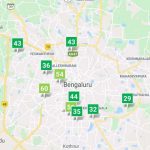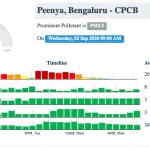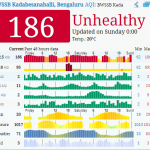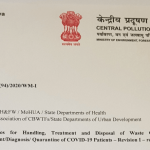

Traditionally, the Central Silk Board junction on Hosur Road adjoining, HSR Layout, BTM Layout, Madiwala and Koramangala, recorded the highest air pollution in Bangalore.
However, after the lockdown from March 25, this polluted cross-section has recorded the least pollution in the city at a healthy Air Quality Index (AQI) of 44, which is considered ‘good’ in plainspeak. Following on its heels is Hebbal at 49.
All the other areas in Bangalore have recorded ‘moderate’ pollution levels with Hombegowda Nagar recording the highest at 64 AQI. Following it closely are Kadabesanahalli and Sanegurava Halli (both at 57 AQI), while Peenya recorded 53. This was the data recorded by the Central Pollution Control Board at 2.40pm today. The information from BTM Layout, Jayanagar and City Railway Station was not available today.
However, one look at the last few days in those areas point out that Jayanagar recorded the healthiest air, even beating Silk Board narrowly on March 26 by scoring 46 compared to 48 of Silk Board. On March 25, BTM Layout beat both Jayanagar and Silk Board to take the top honours at 42 while Silk Board recorded 44 and Jayanagar registered 46.
Contrast this to the pollution on March 24 at 8.30pm and you realise that Kadabesanahalli emerged to be the most polluted at 233 AQI considered ‘very unhealthy’ while Silk Board recorded 107 which is ‘unhealthy only to sensitive groups’. Compare this to Saturday, February 29, and the weekend picture of pollution loads is evident, with the City Railway Station taking the top honours at 113 (‘unhealthy for sensitive groups) while the healthiest was BTM Layout at 51 AQI (‘moderate’).
India statistics
According to the CPCB data recorded at 2.40pm on March 27, the most pollution cities in India were Singrauli (264 AQI), Muzaffarpur (223), and Guwahati (243). The healthiest cities were Narnaul in Haryana (19), Bhiwadi in Rajasthan (28), and Ajmer (36). Bengaluru averaged at 54.



